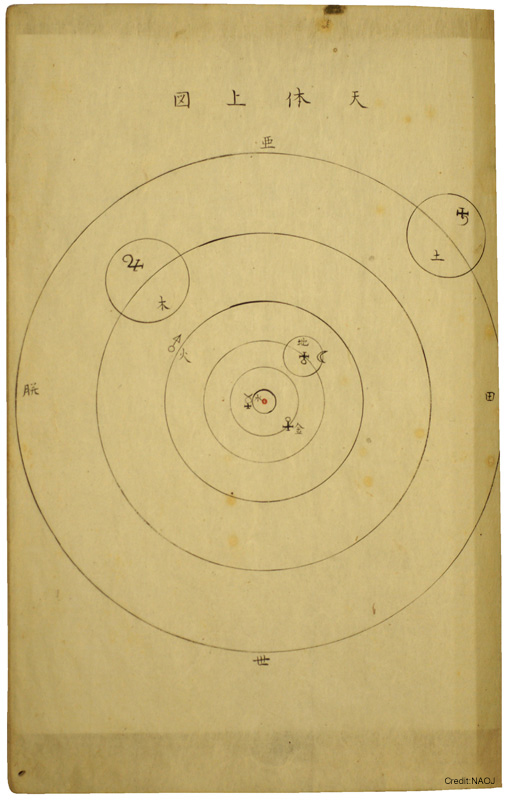New Guidebook for Natural Sciences
Historical illustration・

The “New Guidebook for Natural Sciences” was created by the Nagasaki Interpreter Tadao Shizuki by translating and adding his own annotations to a Dutch version of “Introductiones Ad Veram Physicam Et Veram Astronomiam” written by Englishman John Keill (1660-1806). It discusses such topics as Copernicus’s heliocentric model, Newtonian gravity, Kepler’s laws of planetary motion, and the concept of outer space.
The heliocentric idea had previously been introduced in Japan in 1774 by Nagasaki Interpreter Ryoei Motoki in his translation of a Latin copy of “Tweevoudige Onderwys Van De Hemelsche En Aerdsche Globen” (Japanese title “Tenchi Nikyu Yoho,” “Laws of the Two Spheres of Heaven and Earth.”) But whereas Motoki’s understanding had been limited to conceptual ideas, his student Shizuki was able to fully comprehend Newtonian gravity and on that basis believed the heliocentric model. Shizuki was also the one to coin a Japanese word for the model “chidosetsu.”
Towards the end of the Edo Era, the heliocentric model was distasteful to the Buddhist world, but it gained widespread acceptance within Japan. Japanese astronomers focused on the creation of accurate calendars and astronomical tables; the question of whether the Sun or the Earth was at the center was of little importance. In addition to “chidosetsu” Shizuki coined other words which are still used by Japanese astronomers today: “jyuryoku” (gravity); “kyushinryoku” (centripetal force); and “enshinryoku” (centrifugal force). The list also includes “sakoku” (national isolationism).
It was a long time before an individual appeared who could build upon the success of the disciplines like dynamics and celestial mechanics introduced by the New Guidebook for Natural Sciences. Even the Tenmonkata (Official Astronomer) Kagesuke Shibukawa (1787-1856) was not able to grasp the concepts at first, but he later came to understand; in the “Kanusoron” (An Overview of the Universe) section of “Shinporekishozokuroku (Supplement to the Treatise of the Tenpou Calendar) he discusses concepts like dynamics, celestial mechanics and particles.
(Translator's Note: In addition to the standard Gregorian Calendar, Japan continues to use a reign era calendar. The different eras are defined by changes in the Japanese government, and accompanied by changes in Japanese society.)
Image Data
| Date Created | Between 1798-1802 (Kansei Era 10 - Kyowa Era 2) |
|---|---|
| Author | Tadao Shizuki |
| Credit | Collection of the National Astronomical Observatory of Japan |